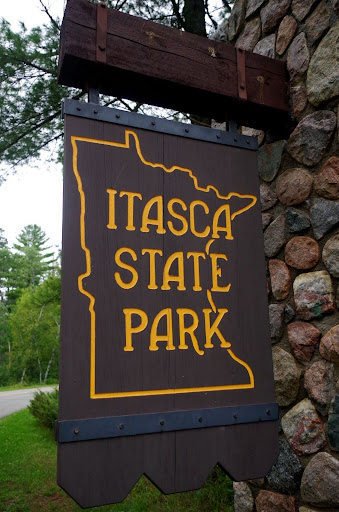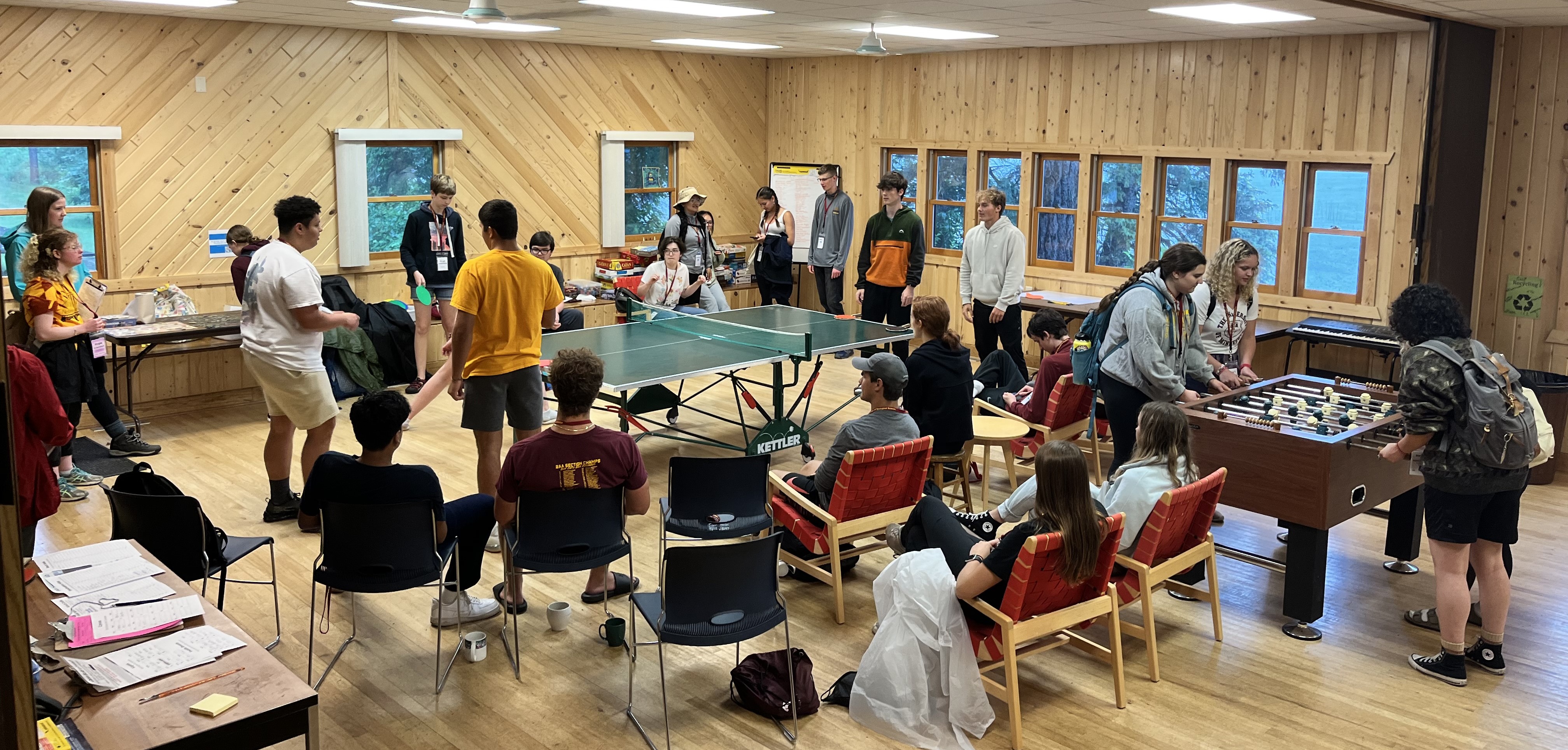The station's 49-acre campus lies completely inside of Itasca State Park, on the eastern shore of Lake Itasca. There is no better place to research and learn about North American natural history and to witness nature, and there are few field stations that can make such an immersion experience as comfortable, welcoming, and meaningful as the Itasca Station. All are welcome, and staff at the station are here to help you join our community with an eye for inclusion, safety, productivity, and fun. This page is your guide to living at the station.
What to Bring
Bedding & towels
The station does not provide bedding. Please bring sheets (twin sized), pillows, blanket (or sleeping bag), and bath/swim towels. Nights are often cool, even in summer, so make sure to pack a warm blanket.
Kitchen and bathroom items (for faculty cabins)
The station provides dish towels, a dish cloth, pot holders, dish soap, hand soap, toilet paper, and trash bags. Station users should bring their own coffee filters (basket style), food storage bags/wrapping, paper towels, and facial tissues.
Clothing and personal items
At field stations it's not about fashion - it's about function! Make sure you pack for a wide range of weather conditions (shorts, long pants, short- and long-sleeved shirts, fleece jacket and/or wool sweater, rain gear, sturdy shoes or boots for fieldwork, warm socks, swimsuit). Avoid cotton clothing, as it does not dry easily and does not keep you warm when wet. Make sure to pack toiletries, medications, sunscreen, a water bottle, bug repellent (see the "Tick-borne diseases" section of our Health and Safety page for recommendations), and laundry detergent. See our printable student packing list for a more complete list.
Parking & Roadways
There is ample parking at the station. A Minnesota state parks vehicle permit must be purchased from the DNR and displayed in all vehicles at the station (MN state vehicles are exempt from this requirement). An annual pass provides access to all Minnesota state parks for an entire year.
Please park in designated areas and do not drive on the grass or off of the roadways. We have many pedestrians and bikers moving around campus, so please drive cautiously on station roadways.
Internet & Cell Service
Wireless internet is available across the station on the University's eduroam network. Station users with a UMN X500 can connect to “eduroam” with their YourInternetID@umn.edu and password when prompted. Those who do not have an x500 can use the “UofM-Guest” network. Cell phone service at the station, and in the State Park in general, is not reliable. Please take that into account so you are not relying on your phone for communication or navigation when you are away from station buildings with wireless access.
Housekeeping, Trash & Laundry
Housekeeping & trash
The station has a small maintenance staff relative to the number of buildings and spaces on our campus. Cabins are cleaned between users, but there is no daily cabin cleaning service. We appreciate station users pitching in to keep spaces tidy during their stay. Cleaning supplies are available on request.
Trash attracts wildlife, including black bears. It is everyone at the station's responsibility that we not habituate bears or other wildlife to eating trash. Bears that are habituated may need to be euthanized. Don't leave trash out overnight. Trash should only be placed in outside receptacles between 6:30-7:30am to coordinate with our maintenance staff rounds. Otherwise, trash should be kept inside cabins or placed in the sanitation building (#67 - see station map). Recycling bins are located across from cabin #2 and in the sanitation building. A fish cleaning house is also located in the sanitation building. Fish cleaning waste should be taken directly to the lockable dumpster near building 73 (see station map for location).
Laundry
There are laundry facilities in the station bathhouses, across from cabin 6 on faculty row, and in the basement of cabin 13. There is no fee to operate the laundry machines, but with sustainability in mind, please make sure loads are full to make the most of a load. Users must provide their own detergent. We use water softener to treat our well water, so use half of the regular amount of detergent to avoid over-sudsing.
Maintenance Requests
If you discover any emergency issues with your cabin, in a building, or station equipment, please notify a station staff member immediately, either in person or by calling Facilities Lead Eric Sather at 218-308-0863.
If you have a non-urgent issue with your cabin/building or equipment, you can report it on one of the designated Maintenance/Repair Request forms, which are located on clipboards in the Assembly Hall and the table under the mailboxes in the Biome Center. You can also email Eric Sather at esather@umn.edu for assistance and repairs.
Families With Children
Families of faculty, staff and researchers are integral to the Itasca Station community and are always welcome. The station tries to be as helpful as possible in maintaining safe and enjoyable conditions for families. However, the station cannot assume responsibility for the conduct and safety of children. There are numerous safety concerns with the waterfront, roadways, laboratories with potential hazards, and wilderness setting. Responsibility for the conduct, safety, and well-being of children at the station belongs to the parent(s). With this in mind, please follow these important guidelines:
- Children under age 12 must have adult supervision at all times.
- An adult must go through the meal service line with children to assist. Our kitchen staff greatly appreciate this, as it helps avoid food waste, spills, and broken dishware.
- Families with children are asked to use extra caution at the station waterfront and on roadways.
- Lab spaces on campus are only accessible to station users 18 and over.
- Children are not allowed to use AV equipment or station computers.
The station provides highchairs (in the dining hall), infant and youth sized life jackets (at the waterfront), and a variety of puzzles, a few toys, and games (in the assembly hall).
Itasca State Park has many amenities that are child- and family-friendly, including a public swim beach with changing rooms and showers, paved bike trails, and a playground. Park naturalists run regular programming that is geared towards audiences of all ages, including some that are specifically for children. Bike trailers and child-sized bikes are available for rent through Itasca Sports.
Additional Guest Policy
Overnight guests of registered station users are not allowed. Anyone staying overnight at the station must be registered through IBSL@umn.edu and will be charged the daily station use fee.
Pets, Support Animals, & Service Animals
Pets, including support animals, are not allowed at the station due to allergen and cleaning considerations in our close communal living setting. Those who do not follow this policy will be asked to leave immediately, and those using station overnight lodging will be charged a $200 minimum cleaning fee. Pet boarding options are available in Park Rapids.
Trained service animals are permitted, but station staff must be notified before arrival so arrangements can be made. According to the UMN Animals on Campus Policy: a Service Animal may accompany its owner on university grounds and in University buildings at all times, except under rare circumstances where the animal’s health or safety may be compromised. Service Animals are not required to wear any special type of harness or garment, and must be under the handler’s control at all times. In situations where it is not obvious that the animal is a Service Animal, university officials may ask the following two qualifying questions:
- Is the Service Animal required because of a person’s disability?
- What work or task has the Service Animal been trained to perform?
It is a misdemeanor under Minnesota Statute 609.833 to misrepresent an unqualified animal as a Service Animal.
Dietary Restrictions
Our kitchen staff is familiar and experienced with accommodating special dietary needs, and dishes are strictly prepared and labeled for people with food allergies. We can provide vegetarian, vegan, gluten-free, dairy-free and other special dietary options upon request. The kitchen will attempt to accommodate requests, but it may not be possible to prepare separate options to meet requests for every meal. Special diet meals that are prepared by kitchen staff are reserved for only those who have made prior arrangements with station staff.
All special special diet requests must be arranged with station staff at IBSL@umn.edu prior to arrival at the station. Program coordinators are responsible for collecting and communicating any special dietary requirements for their group.
Accessibility
Itasca Station is working hard to break down barriers to field participation. As we work to make progress, the station is committed to identifying barriers to access, and communicating accessible aspects of our programs/facilities to help individuals identify whether they can safely participate.
Mobility
Those with mobility concerns should reach out to station staff (IBSL@umn.edu) to learn more about availability of ADA compliant cabins and building access.
Field Biology course learning accommodations
Because the living-learning environment at Itasca is distinct from a typical on-campus class, extra time and communication ahead of the start of Field Biology courses is required of students who request accommodations. See our Student Life and Logistics webpage for more details.
State Park Considerations
Quiet Hours
Quiet hours in the State Park, including the station, are 10 p.m. to 8 a.m. Conversation, music and other sounds must be kept low enough to not disturb others.
Fishing, harvesting, or collecting
Minnesota residents can fish without a fishing license on Lake Itasca, including ice fishing. Non-Minnesota residents can purchase a fishing license online through MN DNR or locally at Rock Creek General Store near the Park's north entrance. It is not allowed to pick wildflowers or other plants, even for personal use in MN State Parks. Click here to learn more about MN State Park regulations.

Recreation
Outdoor activities
Volleyball, softball, soccer, basketball, badminton and horseshoe equipment are available for use on the David Parmelee Memorial Field. Registered station users have access to canoes, kayaks, and paddleboards to paddle from our waterfront on Lake Itasca. Motorized boats are for field courses or research purposes only. Please see our Health and Safety page for waterfront and watercraft safety information.
Opportunities to explore extend well beyond the station limits. Swimming, fishing, canoeing, biking and hiking within Itasca State Park are excellent. If possible, bring your bike to ride the 17-mile paved bike path in the park and for quick trips around the station. A limited number of bicycles will be available for short-term checkout at the station on a first-come basis. Bikes, pontoons, fishing boats and other equipment are also available for rental at the Itasca Sports Rental, located in the Park just 1/2 mile north of the station. For more information on Itasca State Park offerings, visit the Department of Natural Resources website.
Indoor activities
There is indoor recreation equipment in the assembly hall, adjacent to the dining hall, that are available for use by all registered visitors. This includes ping-pong, foosball, ample puzzles, and a variety of board games.
